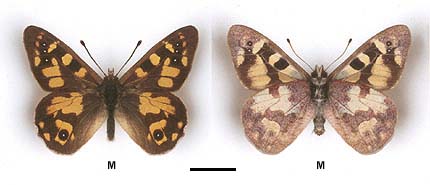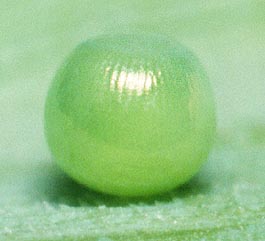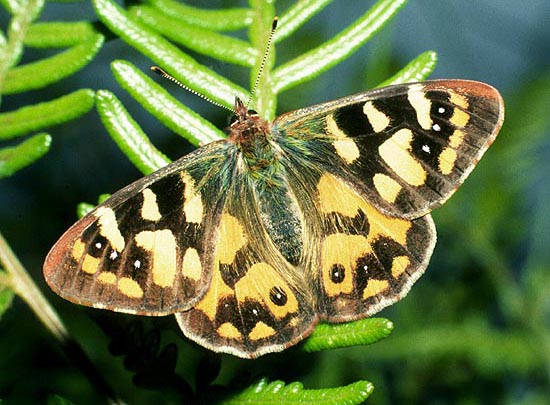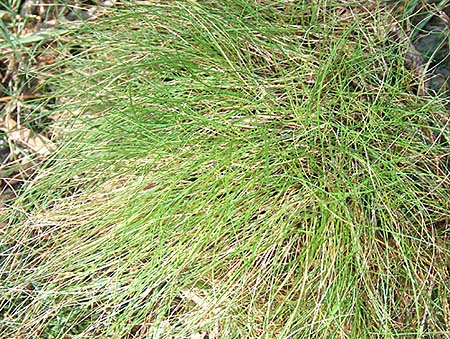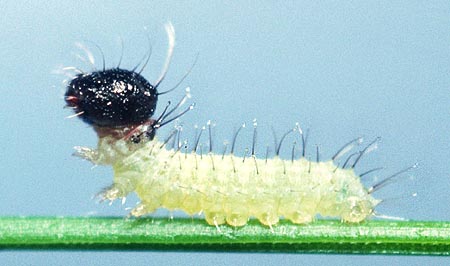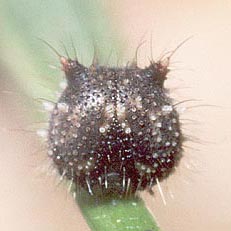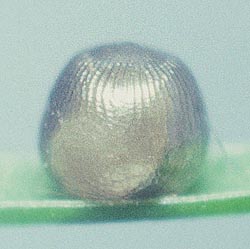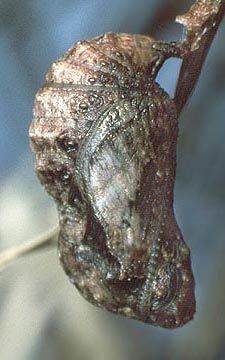-
Larval Food Host
-
Native and introduced grasses including Poa species such as
P. meionectes, Microlaena stipoides (weeping rice-grass)
and possibly Tetrarrhena spp (rice-grasses) (Poaceae).
The larvae feed on the hostplant leaves. In captivity they will eat some
introduced grasses, including *Brachypodium distachyon (false brome),
*Cynodon dactylon (couch), *Poa pratensis (Kentucky blue-grass)
and *Ehrharta erecta (panic veldt grass).
-
Eggs
-
Small, pale green, thin shelled, nearly spherical, shining but with a series of very fine,
indistinct vertical ridges that are more obvious apically but which do not extend onto
the large apical area. The latter has a fine reticulated pattern and in the centre is
the micropylar area, which is raised like a pimple. Usually laid singly on the hostplant,
or sometimes on other plants or debris adjacent to the hostplant. In captivity where
there is less distraction, the females will lay eggs in small groups on the leaves or in
long strings along the hostplant stems. Larva development within the egg commences
immediately after being laid, and larvae begin to emerge in about 8 days in warmer areas
but may take up to 15 days in cool regions. When ready to emerge, the larva incompletely
cuts out a large circular area at the top of the egg, leaving a small uncut portion, and
then pushes the top out like a hinged lid. The egg-shell (chorion) is then eaten by the
larva. In captivity in Adelaide eggs had completed hatching by late November.
In the wild the females lay eggs by first fluttering slowly over the ground to detect the
hostplant, then they usually drop onto or near the hostplant to quickly lay an egg before
flying off again.
-
Larvae
-
The first instar is initially pale yellow with an indistinct whitish, broad longitudinal
dorsal line, and whitish narrow subdorsal and lateral lines. The head is large, finely
rugose, brownish black with some long dark hairs, rounded but divided dorsally and with
a pair of vestigial dorsal horns. The neck area is reddish and there are two dark,
elliptical shaped prothoracic plates. There is a pair of vestigial posterior protrusions
and the posterior anal plate is pale brown. There are longitudinal series of black,
knobbed hairs (setae) along the body that are longer dorsally, and which emanate from
simple smooth, pale coloured conical bases. The knobs are sticky, presumably for
defensive reasons. After eating the green leaves of the hostplant, the larvae gradually
become greenish accentuating a narrow dark green longitudinal dorsal line.
When disturbed, unlike other South Australian satyrs, the early instar larvae raise the
anterior parts of their bodies. They will swing their raised heads back onto any small
predator or disturbance that occurs along their bodies.
The second instar is similar to the late first instar, but the head is rounded, granular,
dark brown, paler laterally and with some obscure pale frontal markings. There is a pair
of short granular dorsal horns. The head and horns are hairy with each hair protruding
from a hard, smooth conical base of variable colour, that are larger on the lateral parts
of the head, and a further large pair occur dorsally posterior to the horns. The tips of
the horns also have a single long hair emanating from a reddish-brown base. The body is
setaceous with dark coloured hairs usually un-knobbed and emanating from white coloured
bases. A short pair of protrusions occur posteriorly, coloured white laterally as an
extension of the white subdorsal line, but pinkish brown internally similar to the anal
plate. A pattern of dark green, elongate diamond shapes, combined with the dark dorsal
line, occur dorsally along the body that become more prominent as the larva grows. The
white subdorsal line is wavy matching the dorsal diamond pattern.
Larvae feed at night, resting during the day hidden in the lower, cooler parts of the
host grass.
The third instar is similar to the second instar but can be green or brownish-green.
There are a lateral series of black dots in the position of the spiracles, and again
dorsally where they occur at each junction of the diamond in the dorsal pattern.
The head is similar but has more vivid colours with a prominent white frontal pattern,
the rear side areas are pale brown, the horns are reddish brown, tipped with a white
conical hair base. The lateral conical hair bases continue to grow as the head enlarges
and are white coloured, the large dorsal pair are reddish brown. The mandibles are red.
The posterior end is forked. The fourth instar is similar to the third instar but is
brown coloured, darker laterally. The dorsal 'diamond' pattern is now very conspicuous,
except the dark coloured diamonds have now changed their diamond shape with the posterior
end of the diamond being pointed while the anterior end is rounded. The dorsal pattern is
also now reinforced with a large posteriorly pointing, dark brown V shape that combines
with the posterior edge of each 'diamond'.
The fifth and final instar is cylindrical shaped, 22-28 mm long, being fatter in the middle,
and the lateral edge is slightly flanged. Only brown larvae have been recorded, of variable
colour intensity from pale to very dark brown. Pale larvae are darker lateral to a pale
zig-zag subdorsal line, and there is a further pale lateral line. There is a very conspicuous,
darker brown, combined 'diamond' and V shaped pattern along the dorsal area similar to the
fourth instar, with each lateral point of the diamond extending to the subdorsal area.
There is a prominent short forked tail protuberance, coloured white laterally as an extension
of the pale subdorsal line, but darker brown internally similar to the diamond pattern.
The body is without long hairs, but supports numerous short pointed secondary setae imparting
a rough scabrous appearance. The head is large, rounded, rugose with numerous short hairs,
with a similar but more obscure pattern compared to the fourth instar, generally brown
coloured with a darker brown peripheral band. There is a prominent pair of orange-brown
coloured, short, rugose, hairy dorsal horns, with a large pale coloured, smooth conical
hair base protruding from the top of each horn. Similar large, smooth hair bases occur
peripherally around the perimeter of the head; five pale orange coloured bases occur on
each side of the head, a white base occurs on each side of the head frontally, and an
orange pair occur dorsally on the top of the head posterior to the horns. Older larvae
tend to be messy and wasteful feeders, eating through the leaves about halfway, letting
the outer half drop to the ground before eating down the lower half.
The larvae can develop very rapidly, and in captivity in Adelaide (from eggs laid in
mid-November) they required only 8 weeks before pupation started in mid-January, but
pupation continued through to early March. Elsewhere, it has been reported that 10
weeks were required in central Victoria and 13-20 weeks near Sydney to complete the
larval period.
-
Pupae
-
Short, stout, compact, 10-12 mm long, suspended head downwards by the cremaster,
the portion of abdomen extending beyond the wings is considerably shorter than
the wings and head combined. The ventral side and wings are essentially smooth,
but the dorsal side has a granular rough appearance. There is a subdorsal row of
short, smooth, rounded conical protuberances along the abdomen and thorax, the
thorax is arched and keeled dorsally with a few obscure knobby protrusions, the
wing bases strongly protrude, the wing junction with the thorax is weakly keeled
and is straight looking from above, the head is wedge shaped anteriorly and weakly
divided, the abdomen is arched dorsally and bluntly curves posteriorly and tapers
to a moderately long, stout, black cremaster. Pupae are cryptically patterned in
brown, reddish brown, brown-black and greys, the abdomen is mostly reddish brown,
the inner-margin half of the wing area is usually pale or whitish, while in dark
patterns there is sometimes a distinct large white spot laterally on the wing termen.
The intensity of the pattern varies from pale to dark, looking like a small piece of
fungus infested wood or sometimes even like a piece of charcoal. The pupa is either
suspended from the hostplant deep within the plant clump near the ground, or the
prepupa leaves the plant to seek more favourable environmental conditions elsewhere.
The pupa cuticle is very thick. Not withstanding this, the pupae likely have a high
susceptibility to desiccation during dry periods or from diseases or field chemicals
during the pupal torpid stage over winter. In captivity very few pupae survive over
winter, which would suggest they require very demanding conditions for survival and
may explain why the adult flight time and numbers are so variable.
-
Flight Period in South Australia
-
Only one brood a year. In southwest Victoria it has a short flight period from
about late October to late November. However, the emergent period varies from
year to year probably dependant on the previous seasons as to how dry it was,
and numbers flying also vary from prolific to virtually absent. The males
emerge earlier than the females. It overwinters as pupae.

-
Distribution
-
The butterfly has yet to be recorded in South Australia. It occurs in southwest
Victoria, 35 km from the SA-Vic border, and so it is expected that this butterfly
may eventually be found in SA, either as vagrants or small resident populations.
The range of the butterfly extends throughout the moist montane and cool coastal
areas of Victoria, NSW and southeast Queensland.
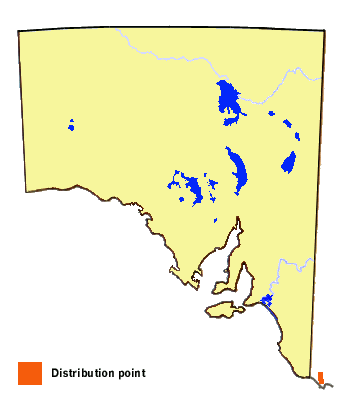
-
Habitat
-
The butterfly requires cool, damp (often leech prone), shady, temperate forest areas
receiving more than about 750 mm of annual rainfall, and having its grass hostplants
in the understorey remaining in a green condition all year round. It requires open
sunlit areas and the understorey to be open and not congested by bracken and tea-tree,
or similar plants. Its original understorey habitat was probably the Poa and
Tetrarrhena grasslands, which require moist conditions. The butterflies are
more often encountered in montane areas with deep moist valleys where the butterflies
can retreat on very hot days, and where the hostplants are more likely to remain in
a green condition. The butterflies and their early stages also seem to best tolerate
average maximum temperatures of less than about 20°C.
-
Conservation Status in South Australia
-
Likely to be extremely rare and localised if found in South Australia, although in the
adjacent areas of Victoria where there has been a better retention of native forests,
the butterflies can sometimes be locally common during good seasons.
-
Threats
-
Suitable cool, moist, tall forest habitat with Poa/Tetrarrhena
understorey is now extremely rare in SA. Such habitat was long ago fragmented
and degraded, or turned into pine plantations. The remaining areas are now under
constant threat from bushfires and understorey degradation from the invasion of
bracken. Bushfires, drought, over grazing by kangaroos, and urban and forestry
expansion would likely be the main threats under present conditions.
-
Conservation Strategy
-
If colonies of the butterfly were found, then they would need to be monitored to
prevent invasion by choking exotic weeds to their habitat, and to prevent over
grazing of the Poa/Tetrarrhena understorey by kangaroos although
some grazing is probably essential to stop the grass from getting too rank.
Toxic agricultural and forestry insecticides and weedicides used in adjacent
areas would need to be judiciously applied, particularly those sprays distributed
by aerial means.
